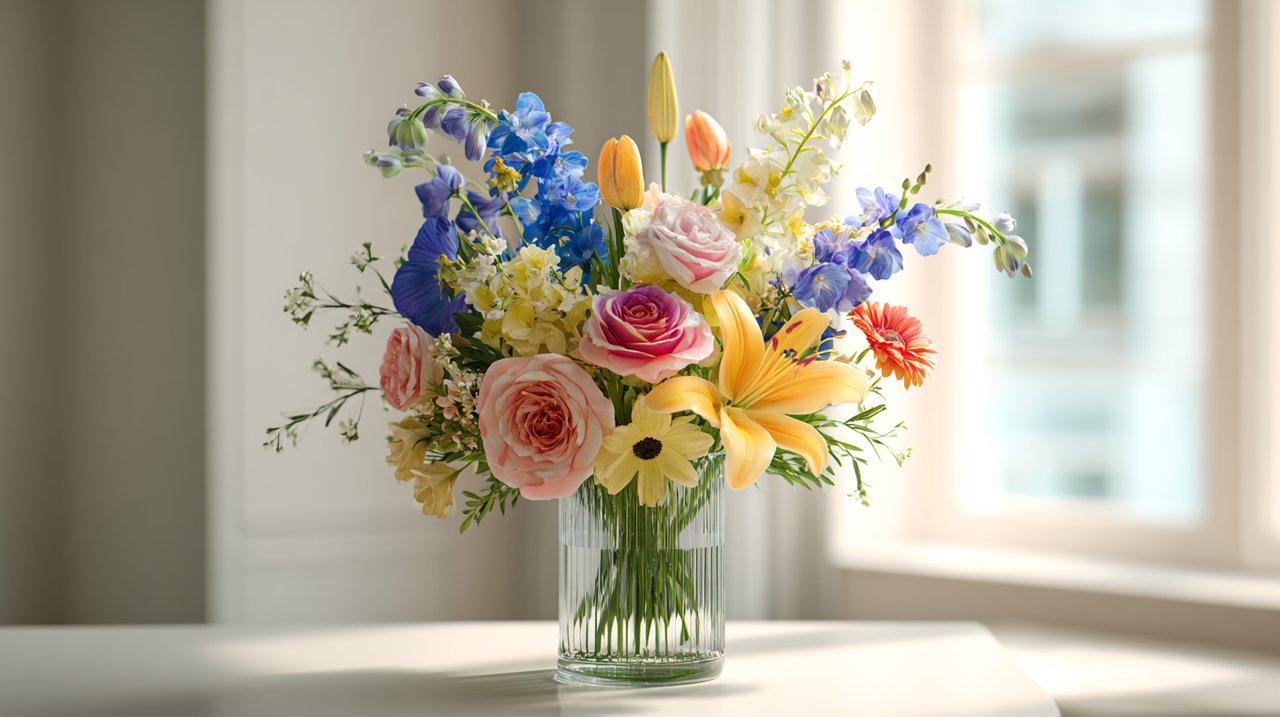Have you ever wondered why some floral arrangements just click? They feel right, balanced, and effortlessly beautiful, almost as if they grew that way. While creating beautiful designs often feels like an art, there’s a powerful secret behind many truly captivating displays: principles rooted in natural order. We’re talking about the 3:5:8 rule.
This guideline, inspired by universal aesthetic principles like the Fibonacci sequence and the Golden Ratio, offers a clear, accessible framework. It helps transform your arrangements from merely pretty to truly artful, tapping into an innate human appreciation for beauty.
Understanding the 3:5:8 Framework
At its heart, the 3:5:8 rule is about creating visual balance and interest through proportion. It suggests using varying heights or quantities of flowers in specific ratios: 3, 5, and 8. You can apply this idea to the height of flowers compared to their vase, or to the number of stems in different clusters within your design.
Let’s break down what each number represents:
- 3: This is your smallest grouping or shortest height. Think of it as your focal point or a distinct, compact cluster of blooms.
- 5: This represents an intermediate grouping or medium height. These elements provide a sense of flow and beautifully support your main focal points.
- 8: This is your largest grouping or tallest height. It typically forms the primary visual anchor and gives the entire design its overall dimension.
Using these proportions helps you achieve an asymmetrical balance. This often feels more organic and captivating than strict symmetry, much like the natural growth patterns we see in the garden.

Roots in Natural Harmony: The Golden Ratio and Fibonacci Sequence
To truly grasp the magic of the 3:5:8 rule, we need to look at its incredible connection to universal patterns. This isn’t just a random guideline; it’s a practical echo of the Fibonacci sequence and the Golden Ratio (roughly 1:1.618). These aren’t just abstract math concepts; they are the hidden blueprints for much of the beauty we see in nature, art, and even architecture.
The Fibonacci sequence is a fascinating series where each number is the sum of the two before it (0, 1, 1, 2, 3, 5, 8, 13, 21, and so on). You’ll find it everywhere in nature’s growth: the elegant spirals of a pinecone, the way seeds are arranged in a sunflower, or how a fern frond unfurls. Even the petal counts on many flowers often follow this sequence – think of lilies with 3 petals or buttercups with 5.
When you compare consecutive Fibonacci numbers, their ratio gets closer and closer to the Golden Ratio. This proportion has been admired for centuries for its inherent beauty and perfect balance. From ancient Egyptians carefully arranging lotus flowers to Renaissance artists, people have instinctively (or intentionally) woven these ratios into their creations, recognizing their pleasing aesthetic.
So, the 3:5:8 rule isn’t just a simple tip. It’s a direct, practical application of a deep mathematical harmony that our eyes are naturally drawn to and find beautiful.
Orchestrating Visual Harmony
Imagine stepping into a room. If a floral arrangement has elements of wildly different, unconsidered heights, it can feel jarring. Your eye might jump around, unable to settle, perhaps seeing a tall bloom overwhelmed by its vase, or the whole piece looking top-heavy.
Now, picture an arrangement crafted with the 3:5:8 rule. Immediately, it feels calm, balanced, and intentionally beautiful. Your gaze flows smoothly through the design, appreciating how each part contributes to a cohesive whole.
Think of applying the 3:5:8 rule like a conductor leading an orchestra. Each flower is an instrument, with its own unique voice and presence. Without a guiding score, individual sounds might be pleasant, but they won’t create a unified, impactful piece. The 3:5:8 rule gives you that score, allowing you to bring diverse botanical elements together into a cohesive visual harmony.

For example, you might choose three striking focal blooms, five secondary flowers to add texture and support, and eight delicate filler flowers or sprigs of foliage to complete the arrangement. This layering creates wonderful depth and dimension, guiding the viewer’s eye naturally through your creation.
When considering heights, a helpful rule of thumb is to make sure your tallest elements (flowers plus vase) are roughly 1.5 to 2 times the height of the vase itself. This ensures your container and its contents are beautifully scaled. Beyond just counting stems, this rule can also help you distribute visual weight and even create intentional negative space, lending a modern touch to your design.
Cultivating Aesthetic Intuition
While the 3:5:8 rule provides a strong foundation, remember it’s a guide, not a rigid law. Floral design is, after all, an art form. Principles like proportion, balance, and rhythm are simply tools to help you achieve harmony.
Experimentation and your personal touch are crucial. By truly understanding the ideas behind the 3:5:8 rule – the pursuit of natural proportion and visual flow – you can move beyond simply counting numbers. Instead, you’ll start to cultivate an intuitive sense of aesthetic balance.
This deeper understanding frees you for creative expression, ensuring your arrangements consistently captivate and delight. So, go ahead and explore; you’re not just following a rule, you’re tapping into the very essence of natural beauty.
💡 Frequently Asked Questions
The 3:5:8 rule is a guideline for floral arrangements that suggests using varying heights or quantities of flowers in specific ratios of 3, 5, and 8. The number '3' typically represents the smallest grouping or shortest height, often serving as the focal point. '5' signifies an intermediate grouping or medium height, supporting the focal points and adding flow. '8' represents the largest grouping or tallest height, acting as the primary visual anchor and giving the design its overall dimension. This asymmetrical balance feels more organic and captivating than strict symmetry.
The 3:5:8 rule is a practical application of universal aesthetic principles inspired by the Fibonacci sequence (0, 1, 1, 2, 3, 5, 8, 13...) and the Golden Ratio (approximately 1:1.618). The Fibonacci sequence appears frequently in nature's growth patterns, and the ratios between consecutive numbers in this sequence approximate the Golden Ratio, which has been admired for centuries for its inherent beauty and perfect balance. The 3:5:8 rule leverages these naturally pleasing proportions in floral design.
The 3:5:8 rule can be applied to the heights of flowers relative to their vase, or to the distribution of visual weight within an arrangement. A practical tip for height is to ensure your tallest elements (flowers plus vase) are roughly 1.5 to 2 times the height of the vase itself. This helps create harmonious scaling between the container and its contents, and can also guide the distribution of negative space for a modern aesthetic.
Using the 3:5:8 rule helps transform floral arrangements from merely pretty to artful by creating visual balance, interest, and flow. It guides the viewer's eye smoothly through the design, making the arrangement feel calm, balanced, and intentionally beautiful. It acts like a conductor's score for an orchestra, bringing diverse botanical elements together into a cohesive visual harmony and adding depth and dimension.

